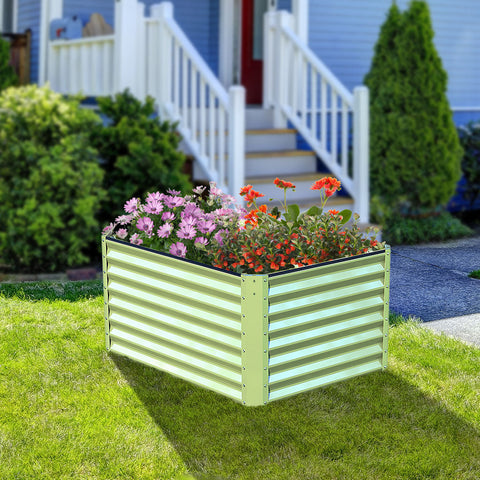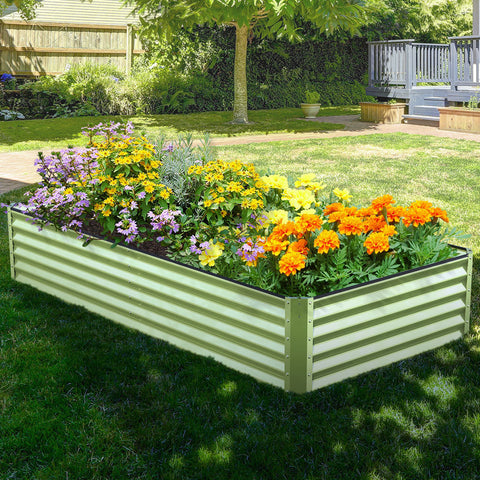A little shade should not prevent you from enjoying a bountiful harvest of local vegetables. Most vegetables grow best in sufficient sunlight, which means they are exposed to direct sunlight for over six hours every day. Fortunately, many crops perform well under partial shading, with three to five hours of direct sunlight or bright speckled sunlight throughout the day. So, don't let a little shade hinder you from growing vegetables, be sure to choose the right one. Most shade tolerant vegetables are grown for their leaves or roots. Unlike tomatoes, chili peppers, pumpkins, cucumbers, and most other fruit crops, these crops do not need to be saturated with sunlight all day to ripen. In fact, a little shade can extend their harvest season by delaying bolting (flowering and seed setting). Some legumes and several herbaceous plants are also happy to be included in a partially shaded vegetable field.The following content also has some reference value for raised garden beds.
Lettuce Like most green leafy vegetables, lettuce can grow well in just three to four hours of direct sunlight. The loose leaf type is the best choice for partial shading. Cut young plants thin and use them as green plants to give the remaining plants more space. Harvest whole or leaf by leaf plants of full size. There are many varieties of lettuce that offer different leaf colors and shapes, so planting several can add vitality to your garden and salad.
Spinach Spinach is a cool seasonal crop that can be grown in spring or autumn. In partially shaded gardens, spring crops may last longer because their germination rate is slower. Partial shading is more helpful for autumn crops because it is sown in late summer when the temperature is high. Shading can keep the soil cool and help with germination and early growth.
Herb Many herbaceous plants perform well in some shade areas if exposed to direct sunlight for four to five hours. Basil, scallions, rosemary, parsley, cherries, and coriander are all good choices. You can put a few of them in a large container, such as half a whiskey bucket, to save space and use a well drained potted mixture. Harvest as needed throughout the summer to add flavor to your meals. Peas Garden peas, crispy peas, and snow peas are all cold season crops, usually planted before the deciduous trees fall in early spring, which may give you extra sunlight in the early stages of the season. As spring approaches and peas mature, the shade provided by nearby trees may help extend their harvest. Shrub bean Shrub beans can do well in some shade areas under at least five hours of sunlight. Crops may take longer to mature, but once beans begin to develop, the plant will continue to produce for several weeks. Radish Radish is another cold season crop that grows best at temperatures ranging from 50 to 65 ° F. They can be sown before the trees fall in spring, so in the early stages of their growth cycle, they can benefit from more sunlight. They need about four to five hours of sunlight to produce delicious bulbs. Hot weather can cause them to sprout, so a little shade can keep them cool and prolong their harvest. Like carrots, they grow vigorously in colder temperatures, so they can be planted in spring or autumn. When seedlings are three to four inches tall, slender plants are separated by two to four inches. Don't forget that carrots and vegetables can also be eaten. Beet Although the roots of sugar beets may not grow as big as they do in sunny conditions, with only four or five hours of sunlight per day, sugar beets can grow well. Don't forget that their leaves can also be eaten, and tender leaves are an excellent supplement for salads and stir fry. Sow sugar beet seeds directly in the soil two to three weeks before the last frost, and sow autumn crops again in late summer.  The seedlings are sparse and spaced about three inches apart. Green Chinese onion Scallions are easy to grow as long as they are sun dried for at least four hours a day. They can start sowing indoors or directly underground. Seedlings thin when young, leaving plants about two inches apart, and can be used in salads, omelets, or decorations. From early spring to summer, sow every few weeks to achieve sustained harvest. Kale Kale is a truly cool customer who thrives in cool temperatures and can spend winter in temperate regions, providing a very long harvest season. Kale has several colors to choose from, including bright green, deep purple, and almost blue. Sow outdoors in early spring and again in summer as autumn and winter crops. By harvesting individual external leaves, the plant continues to produce new leaves from the center. Swiss Chard The leaves and stems of Swiss beets are closely related to beets and can be eaten raw or cooked. Although it is a cold season vegetable, it is more heat-resistant than most green leafy vegetables. It can grow well by basking in the sun for four to five hours every day. Because there are many attractive and colorful varieties here, it is a great choice to mix into ornamental gardens or container planting. Arugula This fast-growing green pepper flavor benefits from the shade, which prevents it from becoming too spicy. Sesame vegetables can be sown in early spring or autumn: sown several times every two weeks to extend the harvest season.
The seedlings are sparse and spaced about three inches apart. Green Chinese onion Scallions are easy to grow as long as they are sun dried for at least four hours a day. They can start sowing indoors or directly underground. Seedlings thin when young, leaving plants about two inches apart, and can be used in salads, omelets, or decorations. From early spring to summer, sow every few weeks to achieve sustained harvest. Kale Kale is a truly cool customer who thrives in cool temperatures and can spend winter in temperate regions, providing a very long harvest season. Kale has several colors to choose from, including bright green, deep purple, and almost blue. Sow outdoors in early spring and again in summer as autumn and winter crops. By harvesting individual external leaves, the plant continues to produce new leaves from the center. Swiss Chard The leaves and stems of Swiss beets are closely related to beets and can be eaten raw or cooked. Although it is a cold season vegetable, it is more heat-resistant than most green leafy vegetables. It can grow well by basking in the sun for four to five hours every day. Because there are many attractive and colorful varieties here, it is a great choice to mix into ornamental gardens or container planting. Arugula This fast-growing green pepper flavor benefits from the shade, which prevents it from becoming too spicy. Sesame vegetables can be sown in early spring or autumn: sown several times every two weeks to extend the harvest season. The leaves harvested during childhood are less than three inches long and have the best taste. The above crops are the best choice for any partially shaded vegetable garden. If you have an adventurous spirit, there are other crops that usually grow well in low sunlight, including cabbage, broccoli, carrots, leeks, turnips, and potatoes. Don't let a little shade hinder you from enjoying the vegetables you grow.
The leaves harvested during childhood are less than three inches long and have the best taste. The above crops are the best choice for any partially shaded vegetable garden. If you have an adventurous spirit, there are other crops that usually grow well in low sunlight, including cabbage, broccoli, carrots, leeks, turnips, and potatoes. Don't let a little shade hinder you from enjoying the vegetables you grow.









